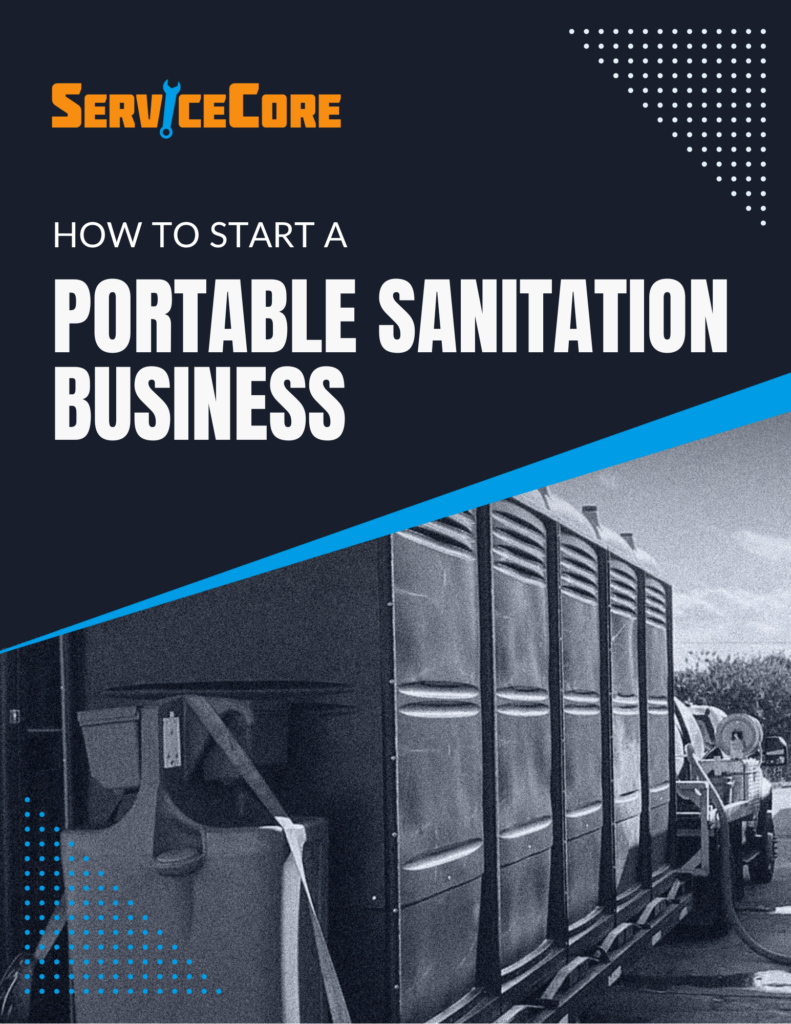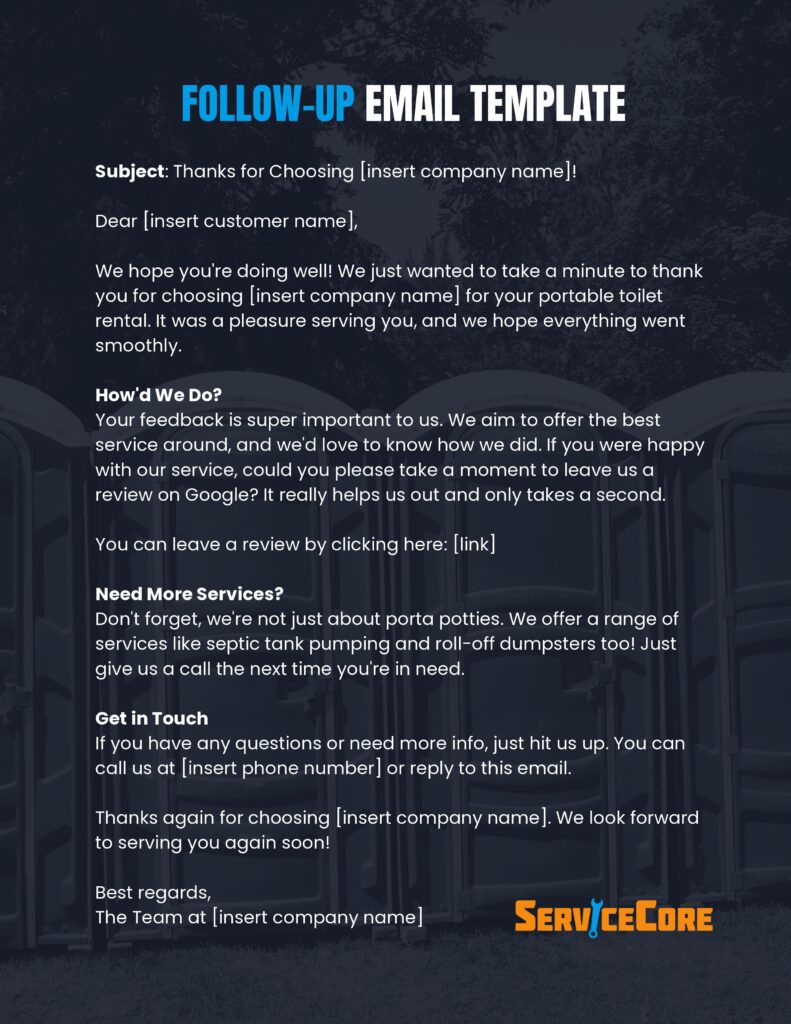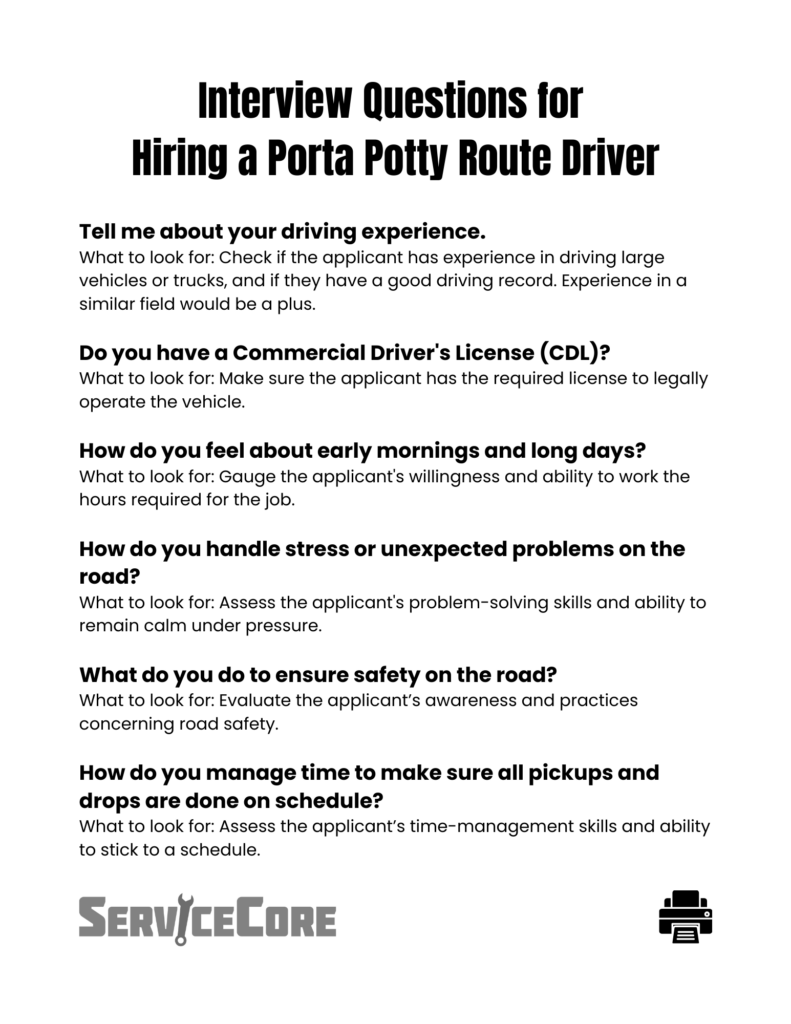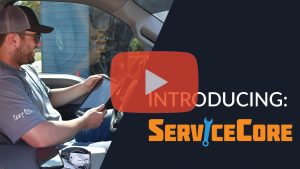Starting and Running a Porta Potty Business: Your Complete FAQ
Welcome to this complete guide which was made for both business owners and customers in the portable sanitation industry. Running a porta potty business has its ups and downs. This article gives you the info you need to do well. From inventory management to customer relations, we cover a variety of topics that are crucial for success in the industry.
ServiceCore is not just another software solution; we’re a trusted partner in the portable sanitation industry. Backed by years of experience and in-depth industry knowledge, we are dedicated to providing you with valuable information. For more information about ServiceCore, click here.
How do you track portable toilets?
Keeping track of your porta potties is key to running a good rental business. If you don’t track your units well, you could double-book, lose porta potties, or have unhappy customers. To combat these challenges, there are specialized software tools designed for the industry. For example, ServiceCore offers an inventory management feature, allowing business owners to know exactly where each of their portable toilets is located at any given time. This simplifies operations and enhances customer service.
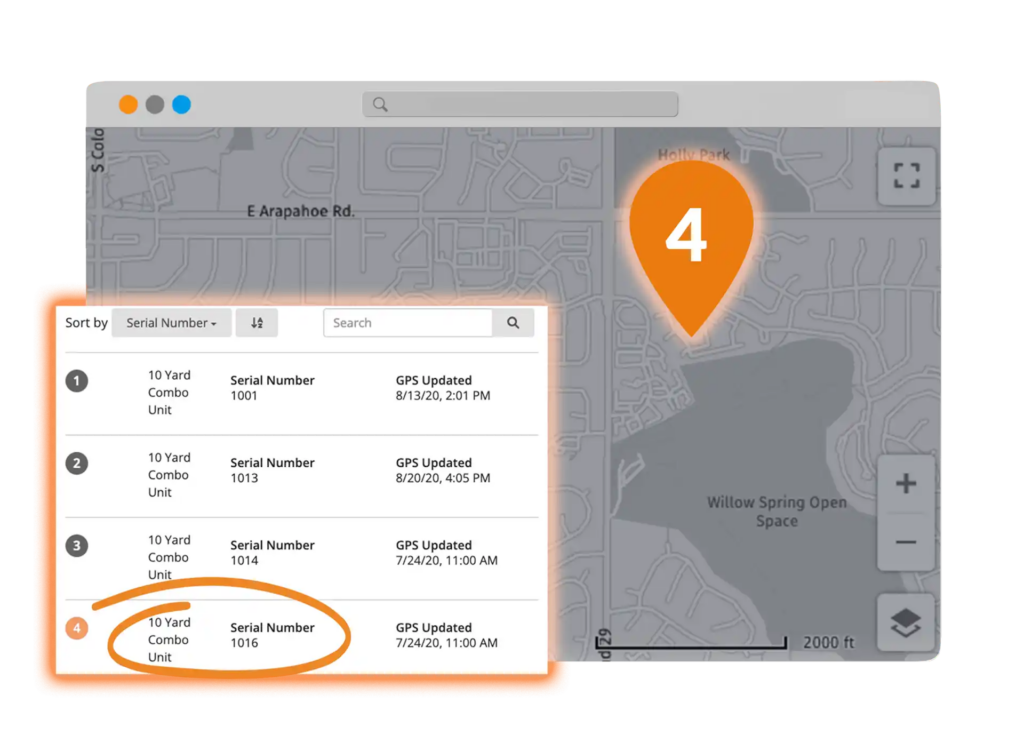
Apart from using software, some businesses use a hand-tracking system. While this can be effective for smaller operations, it can become more complicated as the business grows. A normal system might involve maintaining detailed logs about where each unit is placed, when it was last serviced, and when it is due for pick-up.
Another option that some companies use is barcode or QR code scanning. Each portable toilet is tagged with a unique code that can be scanned during servicing or when the unit is moved. This data is then entered into a software system, allowing for real-time tracking.
How long does a portable toilet last?
How long a porta potty lasts depends on what it’s made of, how often it’s used, and how well you take care of it. Generally speaking, a well-crafted and properly cared-for portable toilet can last anywhere from 5 to 10 years. High-quality portable toilets are usually made from tough, UV-resistant polyethylene material, which helps withstand the wear and tear of daily use and exposure to various weather conditions.
Heavy usage can impact the lifespan of a portable toilet. Units that are consistently rented out and moved from location to location may experience more wear and tear. This can lead to the need for frequent repairs or even full replacement sooner than toilets that are used less frequently.
Taking care of your porta potties regularly helps them last longer. This includes not only routine cleaning but also inspecting for damages and making necessary repairs. Damages to look out for include cracks, leaks, or problems with the door or locking mechanism. Catching and addressing these issues early can significantly extend the lifespan of the unit.
Where can you buy porta potties?
Buying porta potties costs a lot, so knowing where to get them is important for your business. There are various channels through which you can acquire new or used portable toilets, and each has its own set of advantages and drawbacks:
- Manufacturers
- Local Distributors
- Online Retailers
- Used Units
The first option is to buy directly from manufacturers. While this method often provides the best pricing per unit, it usually involves a larger upfront cost because manufacturers typically sell in bulk. Additionally, you may have to handle shipping logistics yourself, adding an extra layer of complexity. Satellite Industries is a manufacturer that you can buy porta potties from.
Another option is to go through local distributors. These entities usually offer a range of products from different manufacturers and might provide additional services like delivery and setup. This is especially useful for small to medium-sized businesses that might not have the capacity to manage large orders. Moreover, local distributors can provide a more personalized service, including tailored advice based on your specific needs.
Online retailers are also a great option. Websites can offer a broad selection of models from various manufacturers, and you can easily compare prices and features. However, you’ll need to consider shipping costs, and there’s a risk that what you see online doesn’t meet your expectations in person.
Used units from other portable toilet rental businesses are another option. These can come at a lower cost but be sure to inspect units and make sure they meet your quality standards. You can find people selling used units in FaceBook groups like this one.
How much does it cost for a porta potty rental?
The cost to rent a porta potty can change a lot based on the type, how long you need it, and where it’s going. Generally, the cost could range from as low as $50 to as high as $500 or more per day. Standard units without any extra features like flushing mechanisms or sinks are usually the least expensive. On the other hand, deluxe or specialized units, such as those with wheelchair accessibility or added amenities like hand sanitizers or solar lights, will cost more.
Location can also influence the price. Renting a portable toilet in a city or high-demand area is often more expensive than in rural areas. Also, delivery and pick-up fees can add to the overall cost, especially if the location is far from the rental company’s warehouse.
Time is another factor. Some companies offer discounts for longer rental periods. For instance, the daily rate could be higher if you’re only renting the unit for a day or two, compared to a week or a month. Most companies also offer service packages that include maintenance and cleaning, and these can add to the overall price.
Payment terms can vary as well. Some companies require a deposit upfront, while others may offer payment plans, especially for longer rental periods or larger orders. It’s a good idea to get quotes from multiple providers and read the terms carefully before making a decision.
How do you dispose of waste from a portable toilet?
Usually, companies use special trucks to pump out the waste from porta potties. These trucks are equipped with large tanks and a vacuum pump system to suction out the waste efficiently. The trucks then transport the waste to approved treatment facilities where it undergoes treatment to meet local and federal disposal standards.
Before transferring the waste to a treatment facility, it’s essential to verify that the facility is equipped to handle and treat the type of waste generated from portable toilets. The waste usually contains a mix of human waste, toilet paper, and chemicals used to minimize odors and break down solids. The treatment facility must be capable of safely processing these elements to prevent environmental contamination.
Once the waste has been treated and processed, it is generally safe to be released into the sewage system or used as fertilizer, depending on local regulations. It’s important to be aware of all local, state, and federal guidelines concerning waste disposal. Failure to comply with these regulations could result in large fines and damage to your business reputation.
How do porta potties work?
A portable toilet, or porta potty, is a self-contained unit that does not require connection to a sewer or septic system. It’s designed to collect and temporarily hold waste in a secure and sanitary manner. The basic components include a holding tank, a seat, and often some form of hand sanitizer or even a sink in more advanced models. Here’s how they work:
The holding tank beneath the seat is where waste is collected. This tank often contains a mixture of water and chemicals. These chemicals serve a dual purpose: they help to break down solid waste and to control odors. When a person uses the porta potty, the waste falls into this holding tank.
For units with flushing capabilities, a pump can be activated to circulate the water and chemical mixture, helping to further reduce odors and distribute waste more evenly within the tank. Non-flushing units are simpler and rely on gravity to move waste into the holding tank.
What software should you use for your porta potty company?
ServiceCore is an all-in-one software made specifically for porta potty businesses. It has features such as route optimization, which helps you plan the most efficient paths for your service trucks, saving both time and fuel. Inventory management capabilities enable you to track the status and location of each portable toilet, ensuring that you know where every unit is at all times. This is particularly helpful in avoiding overbooking and stockouts, enhancing customer satisfaction.
This video shows what ServiceCore can do for your business.
Another important feature of ServiceCore is customer relationship management (CRM). Having a CRM system allows you to maintain all customer information and transaction histories in one place. This availability of data helps in providing better customer service.
Billing and invoicing are other areas where specialized software can make a significant difference. Automated billing systems can generate invoices, process payments, and send reminders, reducing administrative work and minimizing the chances of errors. ServiceCore has billing features to help simplify the accounting and payment processes, and it integrates with QuickBooks.
Click here to learn more about ServiceCore. Click here to get a free, personalized demo with ServiceCore.
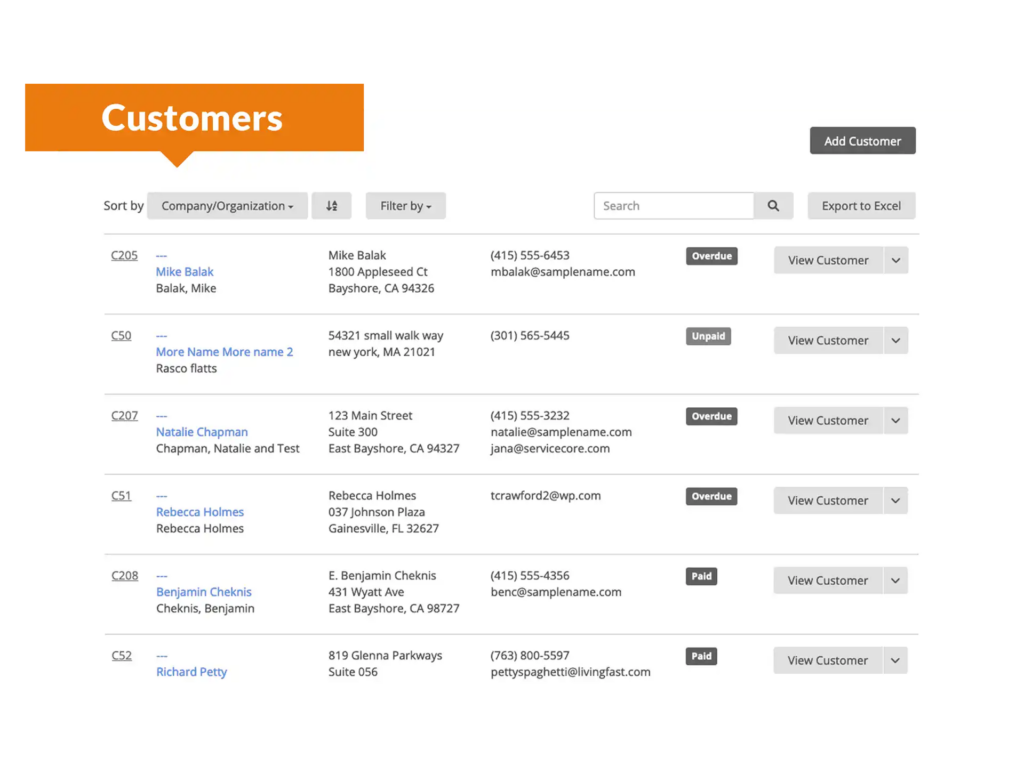
How much do porta potty cleaners make?
(As of October 2023)
The salary for porta potty cleaners can vary widely based on location, the size and reputation of the company, and the level of experience of the cleaner. On average, the pay range can be anywhere from $15 to $30 per hour. This means that, annually, a full-time porta potty cleaner could expect to make between $30,000 and $60,000 before taxes. Some companies also offer benefits like health insurance, paid time off, and retirement plans, which add to the overall compensation package.
Location plays a significant role in determining pay. In larger cities or high-cost-of-living areas, wages tend to be higher for the increased cost of living. On the other hand, smaller towns and rural areas generally offer lower wages.
Experience also factors into how much a cleaner can make. Entry-level cleaners are likely to start at the lower end of the pay scale, while those with several years of experience or specialized skills might earn more. Also, some companies offer performance-based bonuses or commission structures, especially if the cleaner is responsible for servicing a large number of units or managing other aspects of the operation.
How many porta potties should be supplied per person?
The number of porta potties needed for an event or job site depends on several factors, including the number of attendees, the duration of the event, and whether or not food and drinks will be served. However, there are some general guidelines that can help you estimate your needs.
For smaller events with up to 50 people, one to two units are typically sufficient for up to four hours. At larger events, a good rule of thumb is to provide one porta potty for every 50 to 100 attendees, depending on the event’s nature and duration. For example, a music festival that runs all day and serves food and drinks will require more units compared to a short outdoor ceremony.
Job sites have different requirements. OSHA guidelines suggest one toilet for every 20 workers on a 40-hour workweek. However, if the job site is particularly spread out, additional units may be required to ensure that workers don’t have to travel long distances to use the facilities.
Special considerations must also be made for events that have a higher number of women in attendance, as they generally require more time in the restroom. Additional units may also be necessary if alcohol is being served, as this increases restroom usage.
| Number of Attendees | Recommended Number of Units |
|---|---|
| Up to 50 | 1-2 |
| 51-100 | 2-4 |
| 101-200 | 4-6 |
| 201-300 | 6-8 |
| 301-400 | 8-10 |
| 400+ | 10+ |
What types of porta potties are there?
When it comes to porta potties, you’ve got several types to choose from, each serving specific needs and settings. Let’s go over the most common types:
- Standard Units: These are the basic models, usually seen at construction sites or small outdoor events. They’re equipped with a holding tank, seat, and sometimes a urinal, but usually don’t have sinks or flush capabilities.
- Deluxe or Flushable Units: These are similar to standard units but come with a flush mechanism and sometimes even a sink. They are more suitable for events where a slightly higher level of comfort is expected.
- ADA Compliant Units: These porta potties are designed for people with disabilities. They are larger than standard units and come equipped with handrails and flat floors to accommodate wheelchairs.
- Family or Baby Care Units: These units are more spacious and come equipped with a baby changing table, making them ideal for family-friendly events.
- Trailer Units: These are luxury options, often seen at high-end events or weddings. They can include amenities like lighting, mirrors, sinks, and even air conditioning.
- Construction Units: Built specifically for job sites, these units often come with hooks for hanging tools and hard hats. Some may include a urinal in addition to the standard toilet seat.
- High-Rise Units: Designed for construction sites with multi-level buildings, these units are lighter and easier to hoist to upper floors.
- Special Event Units: These are designed for temporary public events like concerts or sports games. They may include additional sinks or even separate compartments for men and women.
- Long-Term Rental Units: These are designed for longer-term needs and usually have a larger holding tank capacity, ideal for extended events or seasonal venues.
Choosing the right type of porta potty depends on the needs of your event or job site. Each type has its own features that make it suited for particular situations, so think about the number of people, event duration, and specific needs when making your choice.
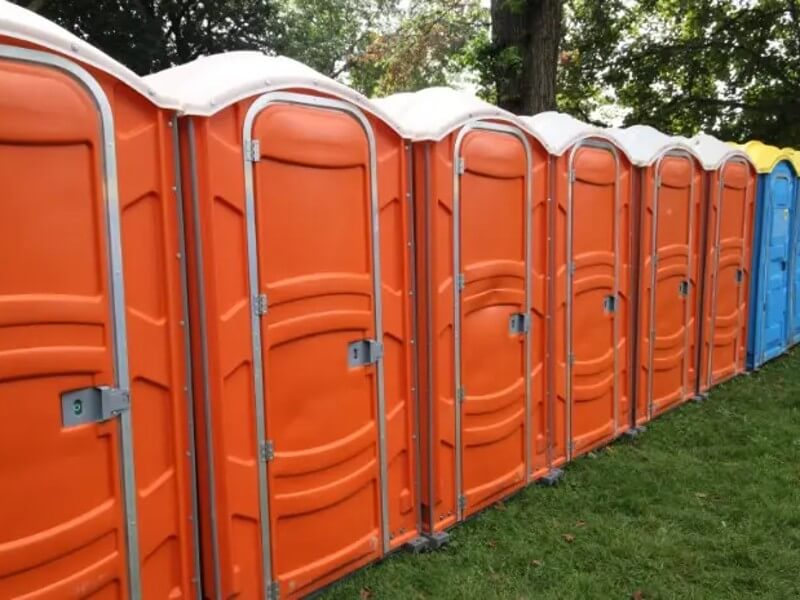
What chemical do porta potties use?
The chemical used in porta potties breaks down waste and controls odors. The most commonly used chemicals are formaldehyde-based solutions or more eco-friendly alternatives like enzyme or bacteria-based solutions.
- Formaldehyde-Based Solutions: These are the traditional chemicals often used in porta potties. They are very effective in breaking down waste and controlling odors. However, they are less environmentally friendly and may not be allowed in certain areas or at certain events that have eco-conscious guidelines.
- Enzyme-Based Solutions: These chemicals use natural enzymes to break down waste and control odors. They are typically less harsh on the environment but might not be as effective at odor control over extended periods of time.
- Bacteria-Based Solutions: These chemicals utilize beneficial bacteria to break down waste naturally. They are also eco-friendly and work well for longer-term applications, like at construction sites or seasonal venues.
- High-Strength Detergents: Some porta potties use high-strength detergents in combination with other chemicals for cleaning and odor control. These are often used in units that have flush mechanisms.
- Smell Additives: To improve the user experience, many companies add fragrances to the chemical mix, which can range from citrus to floral scents.
It’s important to choose the right chemical for your specific needs. Formaldehyde-based solutions are usually more potent but may not be suitable for all locations or events. Enzyme and bacteria-based solutions are more eco-friendly and are gaining in popularity due to increasing environmental awareness.
How are porta potties cleaned?
Cleaning porta potties is a crucial part of maintaining hygiene and ensuring a pleasant user experience. The cleaning process is generally straightforward but involves several important steps to make sure everything is sanitary and in good working order.
- Pumping Out Waste: The first step in cleaning a porta potty is to pump out the waste from the holding tank. This is usually done with a specialized vacuum truck that sucks up all the liquid and solid waste.
- Chemical Replacement: After the waste has been removed, new chemicals are added to the holding tank. These chemicals help break down waste and control odors. The type of chemical used may vary depending on local regulations and customer preferences.
- Scrubbing and Sanitizing: The interior surfaces of the porta potty—like the seat, walls, and urinal—are scrubbed down and sanitized. This is done using specialized cleaning agents designed to kill bacteria and other harmful germs.
- Restocking Supplies: Essential supplies like toilet paper, hand sanitizer, and any additional amenities are restocked.
- Inspection: Finally, a thorough inspection is conducted to ensure that everything is in good working order. This includes checking for any signs of wear and tear or damage that might need repairing.
- Documentation: Some companies maintain cleaning logs that record each service, providing transparency and accountability.
Depending on usage and local conditions, the cleaning frequency can vary. For heavily used porta potties or those used at large events, cleaning may be required multiple times a week. On the other hand, units at less busy locations might be serviced weekly.
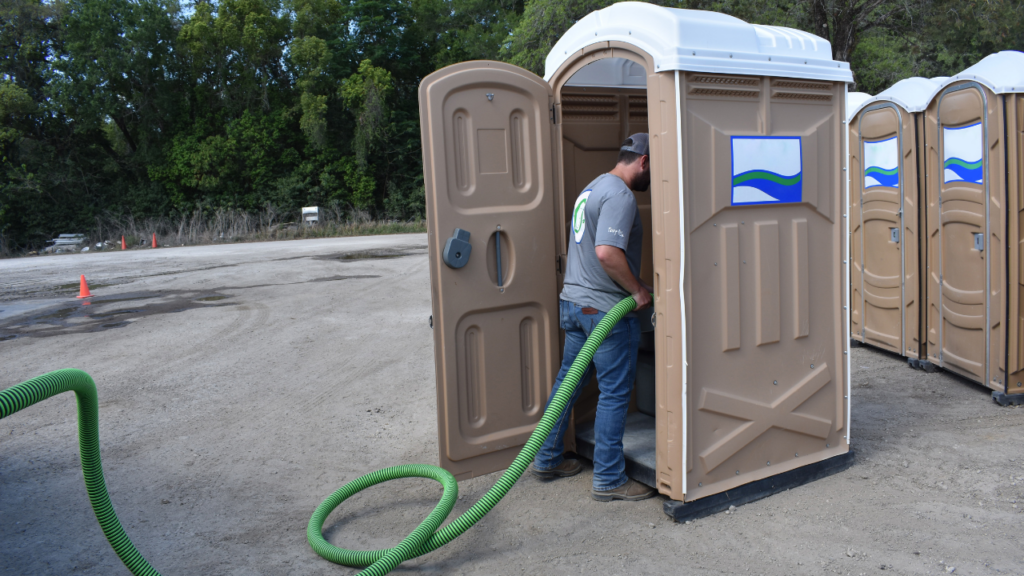
How often should you pump a porta potty?
The frequency of pumping a porta potty depends on a few key factors, including how much the unit is being used and the type of event or setting where it’s placed. Below are some general guidelines:
| Situation | Service Frequency |
|---|---|
| High-Traffic Events | Multiple times a day |
| Construction Sites | Weekly |
| Seasonal or Long-Term Sites | Weekly or Bi-weekly |
| Special Circumstances (e.g., hot weather) | As needed |
| Single-Day Events | Once before the event |
| Multi-Day Events | Daily |
Remember to also think about the capacity of the holding tank or the possibility of an emergency service. The goal is to keep your porta potties clean, functional, and odor-free for everyone who uses them. Regular pumping is not only good customer service but also maintains the lifespan and quality of your units.
What shouldn’t you put in a porta potty?
When using a porta potty, it’s important to be mindful of what you put inside it. The wrong items can clog the system, cause bad odors, or even damage the unit. Here’s a list of things you should avoid putting into a porta potty:
- Non-Biodegradable Items: This includes plastic wrappers, bottles, and cans. These items don’t break down and can cause blockages.
- Baby Wipes or Flushable Wipes: Despite their name, “flushable” wipes do not degrade quickly and can lead to clogs.
- Sanitary Products: Items like tampons and sanitary pads should not be disposed of in a porta potty. They can quickly clog the system and are difficult to remove.
- Food and Beverage: Leftover food and drinks can attract pests and also contribute to unpleasant smells.
- Chemicals: Avoid putting any chemicals like bleach or cleaning agents into the porta potty. These can interfere with the chemicals used to break down waste and control odors.
- Paper Towels or Napkins: These items do not dissolve easily and can contribute to blockages.
- Excessive Toilet Paper: Use only what is necessary as excessive toilet paper can lead to clogs.
- Trash: General trash like shopping bags, straws, or food wrappers should not be thrown into the porta potty.
- Foreign Objects: Toys, stones, or any other foreign objects have no place in a porta potty and can cause serious damage.
- Pet Waste: Pet waste has different bacteria and should not be mixed with human waste in a porta potty.
By being cautious about what goes into a porta potty, you can help make sure that it works properly and is hygienic. Educating users about these guidelines can also be beneficial in keeping your porta potties in the best condition possible.
Click here to read one of our popular articles about strange things you can find in a Porta Potty.
What happens when a porta potty is full?
When a porta potty is full, it becomes unusable and can lead to several issues like bad odors, risk of overflow, and clogs. It’s inconvenient for users and can even damage the unit’s internal systems. Moreover, a full porta potty can result in legal troubles if public sanitation regulations are violated, and it can harm your business reputation. Timely maintenance and pumping are crucial to prevent these problems.
How do you deep clean a porta potty?
Deep cleaning a porta potty is essential for maintaining hygiene and ensuring the unit is pleasant for users. The process involves several steps:
- Pumping: The first thing is to pump out all the waste material from the tank using a vacuum pump. This clears the way for a thorough cleaning.
- Chemical Treatment: After pumping, add a deodorizing agent or sanitizer into the tank. This helps break down waste and controls odors.
- Scrubbing: Using a long-handled brush, scrub the inner walls of the tank as well as the toilet seat, lid, and urinal. This removes any residual waste and stains.
- High-Pressure Washing: Spray the interior with a high-pressure washer to dislodge any remaining grime. This is often done with a soap mixture for enhanced cleaning.
- Disinfecting: Apply a disinfectant to all surfaces, including handles and locks, to kill bacteria and viruses. This is a crucial step, especially during times when infectious diseases are a concern.
- Drying: Allow the unit to air dry, or use towels to dry off any remaining moisture. This ensures that the sanitizing and disinfecting agents have time to work effectively.
- Quality Check: Before declaring the porta potty as clean, do a final check to ensure that it smells fresh, looks clean, and has ample toilet paper and hand sanitizer.
- Replenish Supplies: Refill any consumable items like toilet paper, hand sanitizer, or deodorizing chemicals.
Proper deep cleaning extends the life of your porta potties and ensures that they remain sanitary and pleasant for users. Many companies schedule deep cleans on a regular basis, depending on the frequency of use and the types of events they’re serving.
How much weight can a porta potty hold?
The weight capacity of a porta potty varies depending on the make and model of the unit. However, most standard porta potties are designed to safely accommodate an average adult, typically supporting up to 300-350 pounds.
What is the maximum capacity in a porta potty?
The term “maximum capacity” in a porta potty can refer to two things: the number of people who can use it before it needs servicing, and the number of people it can accommodate at one time. Typically, a standard porta potty is designed for solo use, meaning only one person should be in it at any given time.
In terms of how many uses a porta potty can handle before needing service, that varies depending on the size of the waste tank and the type of event. Most standard units have a waste tank capacity ranging from 60 to 70 gallons. In general terms, a single standard porta potty can handle around 150-200 uses before requiring pumping and cleaning.
How do you optimize porta potty service routes?
Using software tools can make this task much easier and quicker, allowing you to plan the most effective routes in seconds. These tools take into account factors like location, traffic, and the priority of each unit to be serviced. ServiceCore is a great option for this, offering route optimization features specifically tailored for the porta potty business. By using software, you can provide faster service, reduce fuel use, and ultimately, save money and resources.
If you are looking for a resource to help you with routing, check out this e-book about routing.
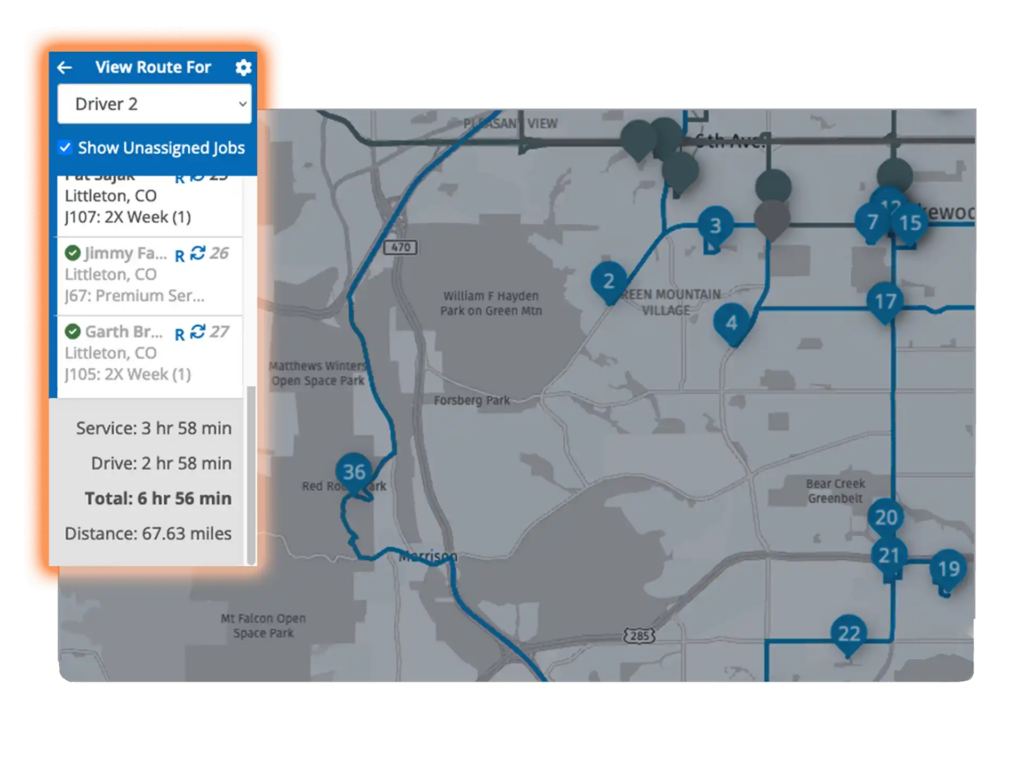
How do I start a porta potty business?
Starting a porta potty business involves several steps and considerations. First, you’ll need to do market research to understand the demand for porta potties in your area and identify your competition. Once you have an idea of the market, create a business plan outlining your goals, strategies, and financial projections.
Securing financing is the next big step. This could be through personal savings, a loan, or investors. You’ll need money for initial purchases like porta potty units, service trucks, and other equipment. Legal processes like registering your business, getting the necessary permits, and taking out insurance are also necessary.
After setting up the business, focus on marketing to attract clients. You can start small with local events and construction sites, then gradually expand as you gain experience and reputation. Customer service is key, so make sure to offer reliable and quality service to build a strong customer base. As your business grows, consider implementing software tools like ServiceCore to manage routes, inventory, customer relationships, and billing more efficiently.
Starting a porta potty business is not without challenges, but with the right planning, financing, and operational strategies, it can be very profitable.
This e-book gives you all the details on starting a portable toilet business. Click here to download the e-book and get started with your business.
How can I handle billing disputes with customers?
When you run into a billing dispute with a customer, the first step is to listen to their concern. Double-check your own records to see if there’s an error. Talk it out with the customer and try to find a middle ground that works for both parties. If the complaint is valid, correct the bill and update the customer. Always put the final agreement in writing, like an email or a new invoice. Here’s a simple way to look at it:
- Listen: When a customer has an issue with their bill, listen carefully to understand the problem.
- Check Records: Look at your billing records to see if the customer’s claim is correct. Sometimes it’s a simple mistake that’s easy to fix.
- Talk: Speak calmly and politely with the customer. Try to find a solution that works for both sides. Maybe you can offer a discount or extra service as a goodwill gesture.
- Fix It: If the dispute is valid, correct the bill and let the customer know. If the dispute is not valid, explain why, using your records as proof.
- Put It in Writing: Whatever you agree on, put it in writing. This could be an email or a revised invoice.
- Learn: Use the experience to improve your billing process so similar issues don’t happen in the future.
By handling billing disputes in a fair and professional way, you not only solve the immediate problem but also build trust with your customers, which is good for business in the long run.
Many companies use software like ServiceCore to reduce billing errors. For example, Elite Sanitation in Mississippi was having issues with a previous software that was causing bills to be sent at the wrong time and disputes with customers. After switching to ServiceCore, the accuracy of their billing processes immediately improved, causing fewer disputes. Read the full case study here.
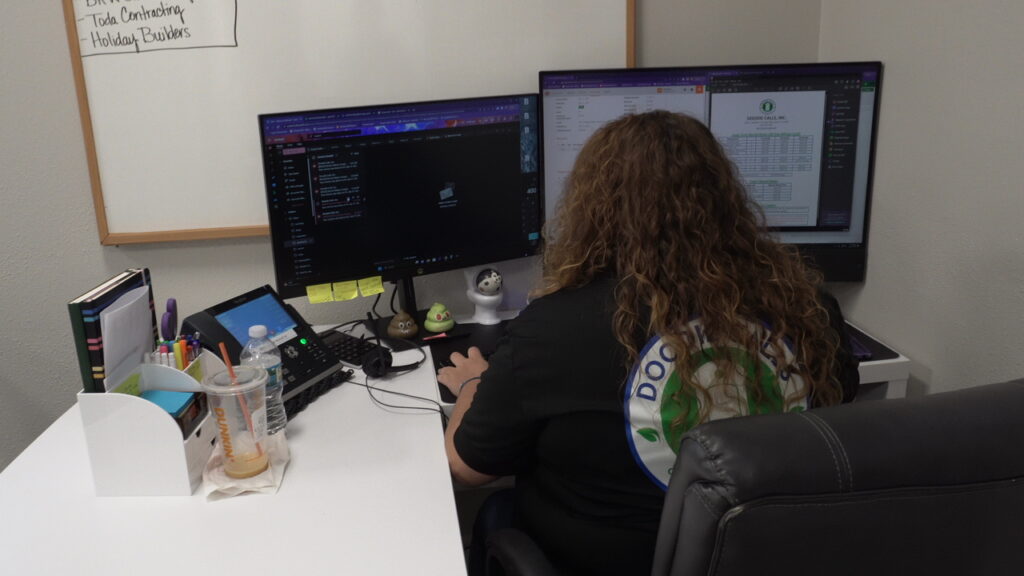
How does route optimization software benefit portable toilet rental companies?
Route optimization software can be a game-changer for portable toilet rental companies. It brings a lot of benefits, including cost-saving, time-efficiency, and improved reliability. Here’s a closer look at these advantages:
Cost-Saving: One of the most immediate benefits is the savings on fuel costs. By optimizing your service routes, the software ensures you take the shortest and most efficient path, which cuts down on unnecessary mileage and fuel consumption.
Time-Efficiency: Time is money, especially in a service-oriented business. Route optimization software helps you to plan out your service schedules more efficiently, allowing you to fit more service stops in a single day. This improves your capacity and potentially increases your revenue.
Improved Reliability: Real-time tracking features allow you to adapt quickly to last-minute changes or emergencies. This flexibility makes your service more reliable, as you can adjust your plans on the fly to meet your clients’ needs.
Better Record-Keeping: The software often includes features that simplify record-keeping. Tracking each service stop and customer interaction can be helpful for future planning, customer service, and billing.
Overall Efficiency: Using specialized software like ServiceCore can bring all these benefits together, making your operations not just cost-effective but also more reliable and efficient as a whole.
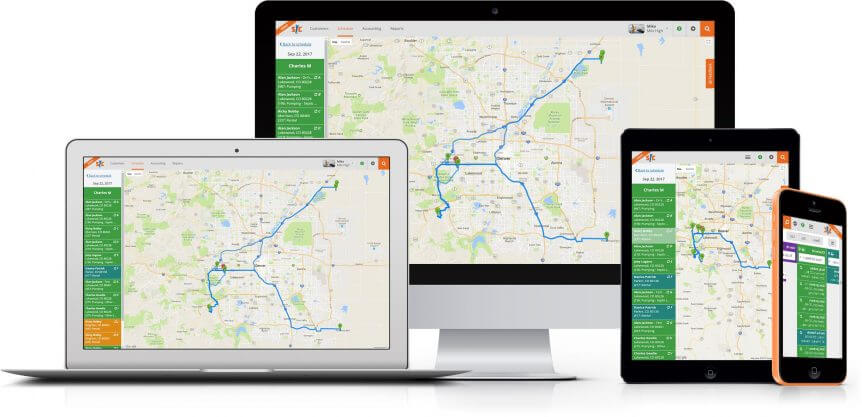
How do you set up pricing plans for porta potty rentals?
Setting up pricing plans for porta potty rentals involves a mix of market research, cost analysis, and customer considerations. By understanding your costs, keeping an eye on the competition, and being flexible with different types of rentals, you can create pricing plans that are both competitive and profitable. Here’s a breakdown of how to go about it:
Research the Market: First, take a look at what your competitors are charging. This gives you a baseline and helps you figure out a competitive rate.
Cost Analysis: Next, calculate how much it costs to maintain, service, and transport a porta potty. This includes things like cleaning supplies, fuel, and staff wages. Make sure the price you set covers these costs and leaves room for profit.
Types of Rentals: Consider different pricing for different types of rentals, such as one-time events versus long-term construction sites. Longer rentals might get a discount, while premium or specialized units could command a higher price.
Additional Costs: Think about any extra charges you might add, like for last-minute bookings, extra cleanings, or delivery to remote locations. Make these clear to customers upfront to avoid disputes later.
Testing and Adjusting: After you set your initial pricing, keep an eye on how it’s working. Are customers happy? Are you covering your costs? Adjust as needed, and don’t be afraid to offer specials or discounts to attract more business.
By carefully setting up your pricing plans, you can ensure a steady revenue stream while keeping your customers satisfied.
What happens when a customer won’t pay?
When a customer won’t pay, start with a polite reminder and escalate through more formal notices and late fees, as outlined in your service contract. If all else fails, consult legal advice for further actions like debt collection or court proceedings. The key is to handle the situation professionally while considering whether to continue doing business with the non-paying customer in the future. Here’s more information on how to approach it:
Initial Reminder: The first step is to send a gentle reminder about the outstanding payment. This could be through an email or a phone call. Sometimes customers genuinely forget, and a simple reminder is all that’s needed.
Follow-Up: If the first reminder doesn’t work, follow up with a more formal notice. Make sure to detail the services provided, the total amount due, and the deadline for payment.
Late Fees: At this point, you might consider adding late fees as specified in your service contract. Always make sure to communicate any added charges to the customer.
Legal Steps: If the customer still doesn’t pay after multiple reminders and late fees, you may need to take legal action. Consult with a legal advisor to understand your options, which could range from a debt collection agency to small claims court.
Future Business: Finally, consider whether or not you want to continue doing business with this customer. Non-payment is a serious issue, and you may decide that it’s not worth the risk.
By following these steps, you can navigate the difficult situation of a non-paying customer while still maintaining professionalism and safeguarding your business.
Here is a video that provides more information about collecting from customers who do not pay:
How do you get reviews for your business on Google?
To get more reviews for your porta potty business, focus on delivering excellent service and then actively requesting feedback. Use strategies like email follow-ups, QR codes on invoices, or direct asks from your drivers to encourage satisfied customers to leave a review. By consistently gathering reviews, you can improve your online presence and attract more customers. Here’s a more detailed breakdown of the process:
Claim Your Business:
The very first step is claiming your business on Google My Business. Visit the Google My Business website, search for your business, and follow the steps to claim it. This process may include verifying your business by phone or mail. Once claimed, you’ll have control over your business listing and how it appears on Google Search and Maps.
Ask for Reviews:
Once your business is verified, start asking your satisfied customers to leave a review. Make this a routine part of your service. After a successful job, kindly ask if they would be willing to share their experience on Google. A simple ask can go a long way. Many businesses include a link or QR code to leave a review on their invoices or follow-up emails.
Here is a template of a follow-up email you can send to customers with a section asking for reviews. You can download it here.
Make it Easy:
To boost the chances of getting a review, make the process as straightforward as possible. In your follow-up emails, include a direct link to your Google My Business review section. Alternatively, you could also add a QR code on your invoices that customers can scan to quickly access the review page.
Respond to Reviews:
Always take the time to respond to reviews, whether they are positive or negative. For positive reviews, a simple ‘Thank you for your support’ can suffice. For negative reviews, politely address the concerns raised and offer to discuss solutions. This shows potential customers that you care about client satisfaction and are proactive about resolving issues. It is always good to stay professional and respectful, even if you are addressing a negative review that isn’t respectful.
Promote Positive Reviews:
Lastly, don’t forget to showcase your positive reviews. You can share them on social media or feature them on your website. This not only gives you content but also serves as social proof, encouraging others to choose your services and leave their own reviews.

By following these steps, you’ll be well on your way to building a large collection of Google reviews, which can significantly impact your business’s success.
Where can I find porta potty driver jobs?
Finding a job as a porta potty driver is relatively straightforward if you know where to look. Here’s a guide to help you on your job search:
Local Companies: Your first port of call should be local portable sanitation companies. They often have job listings on their websites, or you could even walk in and ask about job opportunities. Make sure to have your resume and any necessary certifications handy.
Online Job Boards: Websites like Indeed, Glassdoor, and ZipRecruiter regularly list jobs for porta potty drivers. Simply input the job title and your location to find opportunities near you. Remember to set up job alerts for instant notifications when new jobs are posted.
Networking: Sometimes, the best opportunities come from people you know. If you have friends or acquaintances in the industry, reach out to them. They might know of job openings or could refer you to decision-makers within their companies.
Social Media: Many companies post job openings on their social media platforms, especially on LinkedIn. Follow companies you’re interested in and keep an eye out for job announcements. A great way to use social media to network for driver jobs is through FaceBook groups, where you can connect with porta potty companies that may be looking for drivers.
Trade Shows and Events: Industry events and trade shows offer excellent opportunities to network and learn about job openings. Here, you can meet potential employers face-to-face, giving you a chance to make a lasting impression.
By using these methods, you’ll have a better chance of finding a porta potty driver job that suits your skills and career goals.

What’s the best way to manage porta potty inventory?
Managing porta potty inventory is important for a smooth-running business. The best approach combines specialized software tools, regular audits, clear categorization, and detailed documentation. By employing these methods, you can keep track of your units’ location, condition, and availability, making it easier to meet customer demands and maintain efficient operations. Here’s a detailed guide to help you manage your inventory:
One of the best ways to manage your inventory is by using specialized software, such as ServiceCore, which can help you keep track of your units, their condition, and where they are located. With the right software, you can also automate much of the inventory process, making it more efficient.
Damian Baker, the CEO of a portable sanitation company called VannGo says that one of their biggest challenges before using ServiceCore was managing inventory. “It was a lot of chaos,” said Damian. “Post-it notes, guessing, scrambling around, and a lot of trying to make it work.” Now that Damian is using ServiceCore software to help with inventory management, VannGo can book jobs with confidence knowing exactly how many units are available. Read the full case study here.
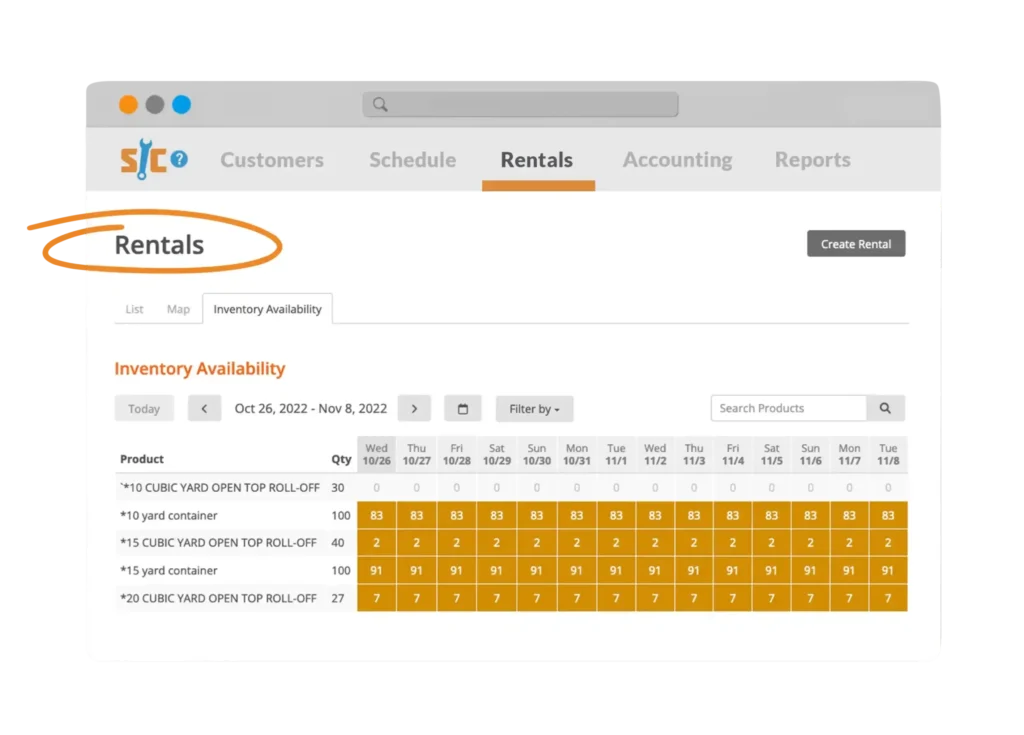
Performing audits is also helpful for managing inventory. It’s essential to regularly check your physical inventory against your records. This can help you identify any discrepancies, losses, or needs for repair and maintenance. Scheduling these audits on a weekly or monthly basis can be very beneficial.
Keeping your porta potties categorized based on type, condition, or location can make it easier to allocate them for specific jobs. This also allows for quicker decisions when dealing with customer demands or emergency situations.
Keep records of maintenance, cleaning, and repairs for each unit. This not only helps you keep your inventory in top condition but also provides valuable data for future purchasing decisions.
By taking a disciplined approach to inventory management and using the right tools, you can ensure that you always know what you have, where it is, and what condition it’s in. This, in turn, allows for smoother operations and happier customers.
How do you market a portable toilet business?
Successfully marketing a portable toilet business involves a mix of digital and traditional strategies. Focusing on local SEO, social media presence, networking within the industry, targeted advertising, and offering promotions can significantly increase your business’s visibility and customer base. By using these tactics, you’re well on your way to growing your profits. Here’s a breakdown of strategies to get your business in front of the right audience:
Local SEO: Make sure your business shows up in local searches on Google. Claim your Google My Business listing and optimize it with relevant keywords, images, and customer reviews. This helps locals easily find you when they’re in need of portable toilet services.
Social Media: Platforms like Facebook and Instagram are great for showcasing your services. Regular posts, customer testimonials, and photos of your clean and well-maintained units can attract new customers.
Networking: Building relationships with event planners, construction companies, and local businesses can provide a steady stream of referrals. Attend industry events and join local business networks to spread the word about your services.
Targeted Advertising: Consider running ads in local newspapers, magazines, or online platforms targeting your core audience. You can also use pay-per-click (PPC) online advertising to target specific search queries related to portable toilets.
Promotions and Discounts: Offering special rates for first-time customers or for large events can entice people to try your services. Just make sure the discounts are sustainable and don’t cut too deeply into your profits.
By using these marketing strategies, you can increase your business’s visibility, attract more customers, and ultimately, grow your profits.
What are the legal requirements for starting a porta potty business?
Starting a septic service business involves several legal steps to ensure you’re operating responsibly and within the law. These requirements range from obtaining the necessary permits to ensuring that you and your employees are adequately insured and trained. Here’s a rundown of the main points to consider:
- Business License: Before you start, make sure you obtain all necessary business licenses and permits. Each state and locality may have its own regulations, so it’s essential to check with local authorities to find out what’s needed.
- Environmental Permits: You’ll need specific permits to collect, transport, and dispose of waste. This often involves working with environmental agencies to ensure that your business operations comply with local, state, and federal laws.
- Insurance: A comprehensive insurance policy is crucial. This should cover liability, property damage, and worker’s compensation. Being adequately insured protects you from legal issues and potential financial loss.
- Contracts and Agreements: Draft clear contracts for your clients outlining the scope of work, payment terms, and other conditions. It’s advisable to consult a lawyer to make sure your contracts are sound.
- Employee Training and Certifications: Ensure that your employees are trained and certified in accordance with state and industry standards, especially for handling hazardous waste and operating specialized machinery.
By fulfilling these legal requirements, you create a strong foundation for your porta potty business to operate on, ensuring long-term sustainability and customer trust.
How do you handle emergency calls for porta potty service?
Handling emergency calls efficiently is crucial for maintaining good customer relations and keeping your business running smoothly. Here are some strategies to ensure you’re prepared for urgent situations:
- 24/7 Contact Line: Have a dedicated phone line that’s operated around the clock. This ensures that you never miss an emergency call and can act on it immediately.
- Quick Response Teams: Have a team ready to deal with emergencies. Make sure they have all the equipment they need and can get to the location as quickly as possible.
- Inventory Checks: Keep a real-time inventory of available units. This allows you to quickly allocate a replacement or additional porta potties as needed.
- Vehicle Tracking: Use GPS or other tracking software to locate your service vehicles. This helps in rerouting them effectively in case of an emergency.
- Customer Communication: Keep the customer informed at every step, from the moment you receive the call until the issue is resolved. Transparency builds trust.
- Extra Charges: Emergency servicing porta potties can be very inconvenient for your business. This is an opportunity to charge extra and boost your bottom line. If you plan to charge extra for emergency calls, be sure to communicate these fees to your customers upfront.
By having a structured approach to handling emergencies, you can ensure quick, effective service that meets your customer’s urgent needs, enhancing your business’s reputation for reliability.
What’s the best way to keep track of customer info in the porta potty business?
Keeping track of customer information is key for running a successful porta potty business. Properly organized data not only streamlines operations but also enhances customer relations. Here’s how to manage this important aspect:
Customer Relationship Management (CRM) Software: Using a specialized CRM tool can centralize all customer information, from contact details to billing history, in one place. ServiceCore has a CRM feature allowing you to store and access customer data.
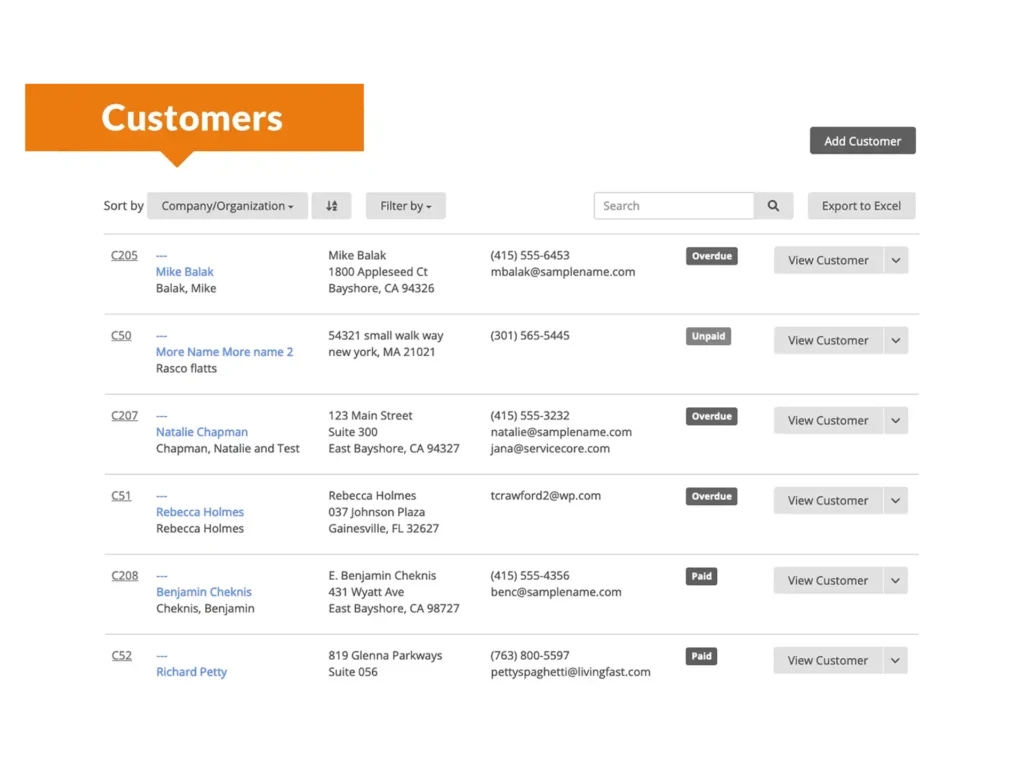
Data Categorization: Organize customer information into useful categories like event type, frequency of service, or specific needs. This makes it easier to tailor your services to each client.
Digital Records: Ditch paper-based systems for a digital format. This not only saves space but also allows easier data retrieval and updating.
Data Security: Ensure that your system is secure to protect sensitive customer information. Use complicated passwords, encryption, and regular security audits to keep data safe.
Regular Updates: Keep the customer data up-to-date. Any changes in contact details, service preferences, or payment methods should be promptly updated in your system.
Keeping track of customer information is important in the porta potty industry, but it’s often easier said than done. Just ask Danielle Jacobs, the Controller at Ace Diversified Services in Holland, Ohio. Before switching to ServiceCore, Ace was drowning in paper and manual processes. Their old way of doing things led to mistakes and frustrations, such as not knowing about a locked gate until a driver returned to the office. After making the switch to ServiceCore, they saw immediate improvements in customer information management. Read the full case study here.
By using these methods, you’ll have a streamlined, efficient way to manage customer information, which can lead to improved customer service and business success.
How do you calculate fuel costs for porta potty service routes?
Calculating fuel costs in the porta potty business is straightforward but crucial for budgeting and pricing your services. You can accurately estimate your fuel expenses by following this simple method:
- Determine Miles-per-Gallon: Find out the average miles-per-gallon (MPG) your service vehicles get. This will be your baseline for how much fuel you’ll need per mile driven.
- Average Fuel Price: Check nearby gas stations to get an average price per gallon of fuel. This will give you an idea of what you’ll be paying each time you refuel.
- Calculate Route Distance: Using route optimization software or even a simple GPS, find out the total distance your drivers will cover for each service route.
- Do the Math: Multiply the average cost per gallon of fuel by the total distance of the route, then divide that by the vehicle’s MPG. For example, if gas costs $3 per gallon and your vehicle gets 10 MPG, and you have a 50-mile route, your calculation would look like this: Fuel Cost = (3*50)/10 = $150
By following this method, you’ll have a reliable way to calculate your fuel costs, allowing you to budget more effectively and set fair pricing for your services.
What are the safety guidelines for porta potty cleaning?
Keeping everyone safe during the porta potty cleaning process is a top priority. Safety measures can protect your staff and customers, as well as ensure that the job gets done effectively. Here are some key safety guidelines:
Personal Protective Equipment (PPE): Make sure your cleaning crew is equipped with gloves, masks, and eye protection to avoid direct contact with hazardous materials.
Chemical Safety: Always follow manufacturer guidelines when using cleaning agents and disinfectants. Properly label and store these chemicals.
Equipment Checks: Before starting, ensure all cleaning equipment is in good working condition to avoid any malfunctions that could lead to accidents.
Ventilation: Make sure the cleaning area is well-ventilated, especially when using chemical cleaners that may release fumes.
Safety Training: Regularly update your team on safety protocols and offer training sessions. This can include how to handle emergency situations like chemical spills.
By following these safety guidelines, you can minimize risks and ensure a safe, efficient cleaning process for your porta potties.
How do you deal with bad weather affecting porta potty service?
Handling bad weather is an inevitable part of the porta potty business. From heavy rain to snowstorms, bad weather can disrupt your service routes and client events. Here’s how you can effectively deal with these challenges:
- Weather Monitoring: Use weather forecasting apps or services to stay updated on upcoming weather conditions. This allows you to make proactive changes to your schedule.
- Communication: Keep an open line of communication with your clients. If weather conditions will affect service, let them know as soon as possible and discuss alternatives or rescheduling.
- Vehicle Preparedness: Make sure your service vehicles are equipped for bad weather. This includes snow tires for winter or chains for muddy conditions.
- Route Adjustments: Based on the weather, adjust your routes to avoid areas that are prone to flooding, snow accumulation, or other hazards.
- Unit Preparations: Sometimes, units can be damaged or removed by high winds or other weather. Consider using additional hardware to keep a unit in place in the event of bad weather.
- Employee Safety: In extreme conditions, prioritize the safety of your staff. If conditions are too dangerous, it may be best to suspend service temporarily.
By staying prepared and flexible, you can mitigate the impact of bad weather on your porta potty service and maintain a high level of customer satisfaction.
What should you look for when hiring porta potty drivers?
When hiring drivers for your porta potty business, it’s important to look at their driving record, experience, customer service skills, physical stamina, and training. These factors will help you find drivers who are reliable, skilled, and a good fit for your company, ensuring a smooth operation and satisfied customers. Here are some details to consider when hiring:
- Driving Record: Check applicants’ driving histories for any red flags like DUIs or multiple speeding tickets. A clean record is usually a good indicator of a reliable driver. Websites like this one can help you check public records.
- Experience: While not mandatory, experience in the sanitation or waste management industry can be a big plus. Familiarity with the equipment and protocols can shorten the training period.
- Customer Service Skills: Drivers often interact with clients, so good communication and people skills are important.
- Physical Stamina: The job may involve lifting heavy equipment or long hours of driving, so physical fitness is a factor to consider.
- Training: Determine what kind of training programs you can offer or that they have already undergone, such as safety protocols or how to use route optimization software.
By carefully considering these factors during the hiring process, you can improve the odds of finding drivers who are not only reliable but also a good fit for your company’s culture.
We made a printable document you can download with interview questions to ask route drivers. Click here to download the document.
The first page of our printable PDF with interview questions for route drivers.
How do you manage seasonal demand for porta potties?
To effectively manage seasonal demand in the porta potty business, it’s essential to forecast demand, adjust staffing levels, employ flexible pricing, closely manage inventory, and maintain clear communication with clients. These strategies help you navigate busy and slow periods, ensuring customer satisfaction while optimizing revenue. Here’s how:
Forecasting: Use past sales data to predict demand for each season. This helps you know how much inventory to keep and when to ramp up your marketing efforts.
Staffing: During peak seasons, you may need to hire temporary staff to handle the increased workload. Make sure they are well-trained to maintain service quality.
Flexible Pricing: Consider offering special prices or packages during slow periods to attract more customers, and adjust your rates during high-demand seasons to maximize revenue.
Inventory Management: Keep track of your inventory closely. Make sure you have enough units, cleaning supplies, and other necessities for peak times.
Communication: Keep an open dialogue with your clients. Let them know about your availability in advance, especially during busy seasons, to help them plan accordingly.
Being proactive in managing seasonal demand will help you keep your customers satisfied while improving your profits. If you find that your business has downtime during the off-season, consider using that time to improve your business and invest in software tools like ServiceCore.
Conclusion
In this all-in-one guide, we’ve answered important questions that both business owners and customers in the porta potty rental industry often have. From managing inventory and optimizing fuel costs to keeping tabs on customer information, we’ve covered the bases. One common thread tying these questions together is the critical role of technology in enhancing your operations. Software solutions like ServiceCore are game-changers. They bring everything under one roof, simplifying complex processes and letting you focus on what truly counts—quality service and business growth.
As we’ve seen from real-world examples, companies that have used ServiceCore in their operations have seen the benefits in terms of efficiency, customer satisfaction, and ultimately, their bottom line. If you’re ready to take your portable sanitation business to the next level, then ServiceCore is the partner you’ve been looking for.
For more information or to get started, give our Sales team a call at 1-844-336-0611
Or you can click here to get a personalized demo and see what ServiceCore can do for your business.

